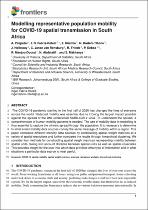 ResearchSpace
ResearchSpace
Modelling representative population mobility for COVID-19 spatial transmission in South Africa
JavaScript is disabled for your browser. Some features of this site may not work without it.
- ResearchSpace
- →
- Research Publications/Outputs
- →
- Journal Articles
- →
- View Item
| dc.contributor.author |
Potgieter, A

|
|
| dc.contributor.author |
Fabris-Rotelli, IN

|
|
| dc.contributor.author |
Kimmie, N

|
|
| dc.contributor.author |
Dudeni-Tlhone, Nontembeko

|
|
| dc.contributor.author |
Holloway, Jennifer P

|
|
| dc.contributor.author |
Janse van Rensburg, C

|
|
| dc.contributor.author |
Thiede, R

|
|
| dc.contributor.author |
Debba, Pravesh

|
|
| dc.contributor.author |
Manjoo-Docrat, R

|
|
| dc.contributor.author |
Abdelatif, N

|
|
| dc.contributor.author |
Makhanya, S

|
|
| dc.date.accessioned | 2021-11-17T07:15:48Z | |
| dc.date.available | 2021-11-17T07:15:48Z | |
| dc.date.issued | 2021-10 | |
| dc.identifier.citation | Potgieter, A., Fabris-Rotelli, I., Kimmie, N., Dudeni-Tlhone, N., Holloway, J.P., Janse van Rensburg, C., Thiede, R. & Debba, D. et al. 2021. Modelling representative population mobility for COVID-19 spatial transmission in South Africa. <i>Frontiers in Big Data, 4.</i> http://hdl.handle.net/10204/12150 | en_ZA |
| dc.identifier.issn | 2624-909X | |
| dc.identifier.uri | https://doi.org/10.3389/fdata.2021.718351 | |
| dc.identifier.uri | http://hdl.handle.net/10204/12150 | |
| dc.description.abstract | The COVID-19 pandemic starting in the first half of 2020 has changed the lives of everyone across the world. Reduced mobility was essential due to it being the largest impact possible against the spread of the little understood SARS-CoV-2 virus. To understand the spread, a comprehension of human mobility patterns is needed. The use of mobility data in modelling is thus essential to capture the intrinsic spread through the population. It is necessary to determine to what extent mobility data convey the same message of mobility within a region. This paper compares different mobility data sources by constructing spatial weight matrices and further compares the results through hierarchical clustering. This provides insight for the user into which data provides what type of information and in what situations a particular source is most useful. | en_US |
| dc.format | Fulltext | en_US |
| dc.language.iso | en | en_US |
| dc.relation.uri | https://www.frontiersin.org/articles/10.3389/fdata.2021.718351/full | en_US |
| dc.source | Frontiers in Big Data, 4 | en_US |
| dc.subject | Covid-19 | en_US |
| dc.subject | Reduced mobility | en_US |
| dc.subject | Spatial weight matrices | en_US |
| dc.subject | Principal component analysis | en_US |
| dc.subject | Hierarchical clustering | en_US |
| dc.title | Modelling representative population mobility for COVID-19 spatial transmission in South Africa | en_US |
| dc.type | Article | en_US |
| dc.description.pages | 22 | en_US |
| dc.description.note | Copyright © 2021 Potgieter, Fabris-Rotelli, Kimmie, Dudeni-Tlhone, Holloway, Janse van Rensburg, Thiede, Debba, Manjoo-Docrat, Abdelatif and Khuluse-Makhanya. This is an open-access article distributed under the terms of the Creative Commons Attribution License (CC BY). The use, distribution or reproduction in other forums is permitted, provided the original author(s) and the copyright owner(s) are credited and that the original publication in this journal is cited, in accordance with accepted academic practice. | en_US |
| dc.description.cluster | Next Generation Enterprises & Institutions | en_US |
| dc.description.cluster | Smart Places | en_US |
| dc.description.impactarea | Data Science | en_US |
| dc.description.impactarea | ISSR Management Area | en_US |
| dc.identifier.apacitation | Potgieter, A., Fabris-Rotelli, I., Kimmie, N., Dudeni-Tlhone, N., Holloway, J. P., Janse van Rensburg, C., ... Makhanya, S. (2021). Modelling representative population mobility for COVID-19 spatial transmission in South Africa. <i>Frontiers in Big Data, 4</i>, http://hdl.handle.net/10204/12150 | en_ZA |
| dc.identifier.chicagocitation | Potgieter, A, IN Fabris-Rotelli, N Kimmie, Nontembeko Dudeni-Tlhone, Jennifer P Holloway, C Janse van Rensburg, R Thiede, et al "Modelling representative population mobility for COVID-19 spatial transmission in South Africa." <i>Frontiers in Big Data, 4</i> (2021) http://hdl.handle.net/10204/12150 | en_ZA |
| dc.identifier.vancouvercitation | Potgieter A, Fabris-Rotelli I, Kimmie N, Dudeni-Tlhone N, Holloway JP, Janse van Rensburg C, et al. Modelling representative population mobility for COVID-19 spatial transmission in South Africa. Frontiers in Big Data, 4. 2021; http://hdl.handle.net/10204/12150. | en_ZA |
| dc.identifier.ris | TY - Article AU - Potgieter, A AU - Fabris-Rotelli, IN AU - Kimmie, N AU - Dudeni-Tlhone, Nontembeko AU - Holloway, Jennifer P AU - Janse van Rensburg, C AU - Thiede, R AU - Debba, Debba AU - Manjoo-Docrat, R AU - Abdelatif, N AU - Makhanya, S AB - The COVID-19 pandemic starting in the first half of 2020 has changed the lives of everyone across the world. Reduced mobility was essential due to it being the largest impact possible against the spread of the little understood SARS-CoV-2 virus. To understand the spread, a comprehension of human mobility patterns is needed. The use of mobility data in modelling is thus essential to capture the intrinsic spread through the population. It is necessary to determine to what extent mobility data convey the same message of mobility within a region. This paper compares different mobility data sources by constructing spatial weight matrices and further compares the results through hierarchical clustering. This provides insight for the user into which data provides what type of information and in what situations a particular source is most useful. DA - 2021-10 DB - ResearchSpace DP - CSIR J1 - Frontiers in Big Data, 4 KW - Covid-19 KW - Reduced mobility KW - Spatial weight matrices KW - Principal component analysis KW - Hierarchical clustering LK - https://researchspace.csir.co.za PY - 2021 SM - 2624-909X T1 - Modelling representative population mobility for COVID-19 spatial transmission in South Africa TI - Modelling representative population mobility for COVID-19 spatial transmission in South Africa UR - http://hdl.handle.net/10204/12150 ER - | en_ZA |
| dc.identifier.worklist | 25067 | en_US |





